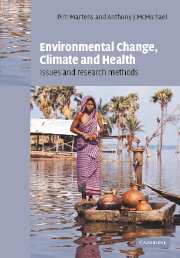Book contents
- Frontmatter
- Contents
- List of contributors
- Foreword
- 1 Global environmental changes: anticipating and assessing risks to health
- 2 Historical connections between climate, medical thought and human health
- 3 The contribution of global environmental factors to ill-health
- 4 Surprise, nonlinearity and complex behaviour
- 5 Epidemiological and impacts assessment methods
- 6 Retrospective studies: analogue approaches to describing climate variability and health
- 7 Detecting the infectious disease consequences of climate change and extreme weather events
- 8 Integrated Assessment modelling of human health impacts
- 9 Remote sensing, GIS and spatial statistics: powerful tools for landscape epidemiology
- 10 Monitoring the health impacts of global climate change
- 11 Epidemiology, environmental health and global change
- 12 Dealing with scientific uncertainties
- Index
- Plate section
- References
4 - Surprise, nonlinearity and complex behaviour
Published online by Cambridge University Press: 28 July 2009
- Frontmatter
- Contents
- List of contributors
- Foreword
- 1 Global environmental changes: anticipating and assessing risks to health
- 2 Historical connections between climate, medical thought and human health
- 3 The contribution of global environmental factors to ill-health
- 4 Surprise, nonlinearity and complex behaviour
- 5 Epidemiological and impacts assessment methods
- 6 Retrospective studies: analogue approaches to describing climate variability and health
- 7 Detecting the infectious disease consequences of climate change and extreme weather events
- 8 Integrated Assessment modelling of human health impacts
- 9 Remote sensing, GIS and spatial statistics: powerful tools for landscape epidemiology
- 10 Monitoring the health impacts of global climate change
- 11 Epidemiology, environmental health and global change
- 12 Dealing with scientific uncertainties
- Index
- Plate section
- References
Summary
Introduction
The world is stranger than we can imagine and surprises are inevitable in science; thus we found, for example, that pesticides increase pests, antibiotics can create pathogens, agricultural development creates hunger and flood control leads to flooding (Levins, 1995a, b). But some of these surprises could have been avoided if the problems had been posed so as to accommodate solutions in the context of The Whole, taking complexities into account. Predicting the impact of a changing world on human health is a hard task and requires an interdisciplinary approach drawn from the fields of evolution, biogeography, ecology and social sciences, and relies on various methodologies such as mathematical modelling and historical analysis (Awerbuch, 1994; Levins, 1995a, b; Awerbuch et al., 1996; McMichael, 1997). Indeed, integrated assessment modelling of human health has been recommended as a global methodology to develop prevention strategies, educate policy makers and assess the impact of interventions (Martens, 1998; see also Chapter 8).
When even a simple change occurs in the physical environment, its effects percolate through a complex network of physical, biological and social interactions that feed back and feed forwards. Along some pathways the effects are attenuated and may even disappear; along others they are amplified and can show up at points far removed from their original entry into the system; along still other pathways the effects may be reversed so that, for example, heating may lower the temperature or adding nitrogen to a lake may reduce the nitrogen level (Levins & Lane, 1977).
- Type
- Chapter
- Information
- Environmental Change, Climate and HealthIssues and Research Methods, pp. 96 - 119Publisher: Cambridge University PressPrint publication year: 2002
References
- 5
- Cited by



